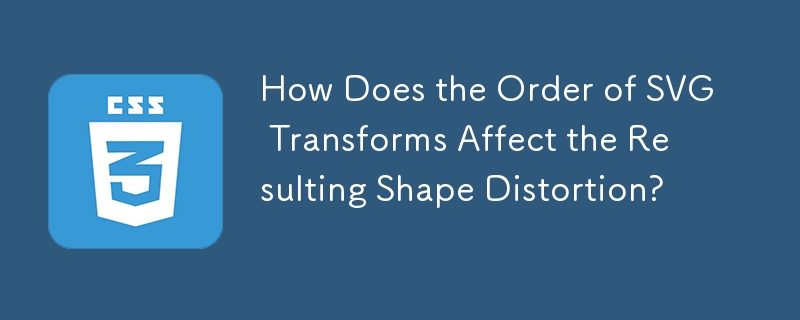 Web Front-end
Web Front-end
 CSS Tutorial
CSS Tutorial
 How Does the Order of SVG Transforms Affect the Resulting Shape Distortion?
How Does the Order of SVG Transforms Affect the Resulting Shape Distortion?
How Does the Order of SVG Transforms Affect the Resulting Shape Distortion?

Order of Transforms and the Resulting Distortion
In SVG, when a transform attribute is applied to an element, it obtains a copy of the current user coordinate system. The subsequent transforms are then applied in sequence, each modifying the coordinate system from its previous state.
This order of transformations significantly affects the final output. As noted in the specified quotes:
- Transformations are applied in the order they appear in the transform attribute.
- Each transformation affects the coordinate system based on the changes applied by preceding transformations.
Skewing Due to Transforms Sequence
Consider the example in the code provided, where two rectangles undergo transformations:
Rectangle 1: Scale(2, 1) then Rotate(10deg)
Rectangle 2: Rotate(10deg) then Scale(2, 1)
Rectangle 1 is distorted or skewed due to the specific order of the transforms. When the element undergoes scaling, its current coordinate system is first elongated horizontally. This new coordinate system is then rotated by 10 degrees. As a result, the rectangle is effectively skewed.
In contrast, Rectangle 2 is not skewed because of the reversed transform order. The initial rotation of 10 degrees modifies the coordinate system before scaling occurs. Therefore, the scaling simply elongates the rectangle along the new rotated axis, avoiding any distortion.
Technical Explanation
When scaling is applied first, the element's bounding box is enlarged or contracted. When the rotation transform is then applied, it occurs within this modified bounding box. This leads to the skewing effect as the rotation is applied to the scaled proportions.
Conversely, when rotation is applied first, it alters the orientation of the coordinate system. Subsequently, scaling is applied to this rotated system, ensuring that elongation or contraction occurs along the new axis, resulting in a non-skewed rectangle.
By understanding the order and interplay of transforms, it becomes clear why chaining transforms in different sequences can result in varying outcomes, as observed in this example.
The above is the detailed content of How Does the Order of SVG Transforms Affect the Resulting Shape Distortion?. For more information, please follow other related articles on the PHP Chinese website!

Hot AI Tools

Undresser.AI Undress
AI-powered app for creating realistic nude photos

AI Clothes Remover
Online AI tool for removing clothes from photos.

Undress AI Tool
Undress images for free

Clothoff.io
AI clothes remover

Video Face Swap
Swap faces in any video effortlessly with our completely free AI face swap tool!

Hot Article

Hot Tools

Notepad++7.3.1
Easy-to-use and free code editor

SublimeText3 Chinese version
Chinese version, very easy to use

Zend Studio 13.0.1
Powerful PHP integrated development environment

Dreamweaver CS6
Visual web development tools

SublimeText3 Mac version
God-level code editing software (SublimeText3)

Hot Topics
 Stacked Cards with Sticky Positioning and a Dash of Sass
Apr 03, 2025 am 10:30 AM
Stacked Cards with Sticky Positioning and a Dash of Sass
Apr 03, 2025 am 10:30 AM
The other day, I spotted this particularly lovely bit from Corey Ginnivan’s website where a collection of cards stack on top of one another as you scroll.
 Google Fonts Variable Fonts
Apr 09, 2025 am 10:42 AM
Google Fonts Variable Fonts
Apr 09, 2025 am 10:42 AM
I see Google Fonts rolled out a new design (Tweet). Compared to the last big redesign, this feels much more iterative. I can barely tell the difference
 How to Create an Animated Countdown Timer With HTML, CSS and JavaScript
Apr 11, 2025 am 11:29 AM
How to Create an Animated Countdown Timer With HTML, CSS and JavaScript
Apr 11, 2025 am 11:29 AM
Have you ever needed a countdown timer on a project? For something like that, it might be natural to reach for a plugin, but it’s actually a lot more
 Why are the purple slashed areas in the Flex layout mistakenly considered 'overflow space'?
Apr 05, 2025 pm 05:51 PM
Why are the purple slashed areas in the Flex layout mistakenly considered 'overflow space'?
Apr 05, 2025 pm 05:51 PM
Questions about purple slash areas in Flex layouts When using Flex layouts, you may encounter some confusing phenomena, such as in the developer tools (d...
 HTML Data Attributes Guide
Apr 11, 2025 am 11:50 AM
HTML Data Attributes Guide
Apr 11, 2025 am 11:50 AM
Everything you ever wanted to know about data attributes in HTML, CSS, and JavaScript.
 How to select a child element with the first class name item through CSS?
Apr 05, 2025 pm 11:24 PM
How to select a child element with the first class name item through CSS?
Apr 05, 2025 pm 11:24 PM
When the number of elements is not fixed, how to select the first child element of the specified class name through CSS. When processing HTML structure, you often encounter different elements...
 A Proof of Concept for Making Sass Faster
Apr 16, 2025 am 10:38 AM
A Proof of Concept for Making Sass Faster
Apr 16, 2025 am 10:38 AM
At the start of a new project, Sass compilation happens in the blink of an eye. This feels great, especially when it’s paired with Browsersync, which reloads
 In front-end development, how to use CSS and JavaScript to achieve searchlight effects similar to Windows 10 settings interface?
Apr 05, 2025 pm 10:21 PM
In front-end development, how to use CSS and JavaScript to achieve searchlight effects similar to Windows 10 settings interface?
Apr 05, 2025 pm 10:21 PM
How to implement Windows-like in front-end development...





